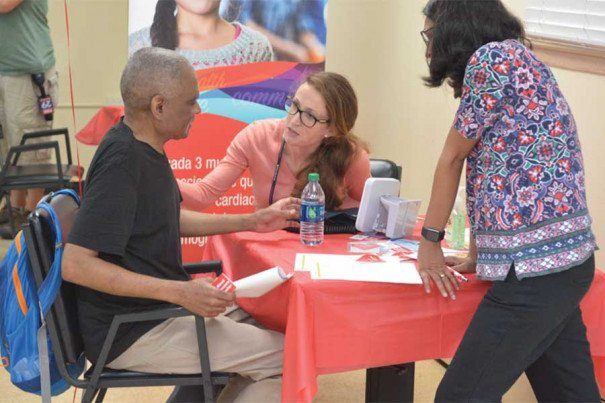Bridging the Gap: These Philadelphians Are Working to Improve Health Equity

When Dr. Deon Vigilance moved from Indiana to Philadelphia, the heart surgeon began to notice a dangerous trend among his West Philadelphia patients. Most of the patients who came into the Trinity Health Mid-Atlantic Mercy Fitzgerald campus needing emergency open heart surgery required stabilization for two to three days before he could operate. Some came in with sky-high blood pressure while others had out of control sugar levels.
“Primary conditions or risk factors weren’t appropriately addressed in the communities where they live, so they came in sicker than they should be,” he says.
Dr. Vigilance’s experience is not unique. The health care gap between minority and non-minority populations continues to grow in the United States, putting the former at higher risk for diabetes and cardiovascular disease. According to the National Institutes of Health, Black adults are twice as likely to develop high blood pressure compared to white adults. An American Heart Association study found that, in Latinx communities, 52.3 percent of men and 42.7 percent of women age 20 and older had cardiovascular disease. And in LGBTQ+ communities, new research is shedding light on their higher risk for hypertension, high cholesterol and diabetes.
And it’s not simply a matter of biology or genetics, says Billy A. Caceres, PhD, an assistant professor at Columbia University’s School of Nursing who works in the school’s Center for Sexual and Gender Minority Health Research.
“What we know is that most health disparities are due to social factors like poverty, poor access to health care, discrimination and neighborhood violence,” he explains. “All of those things are what contribute to the health disparities that we see between racial and ethnic minorities and white populations.”
Barriers to Care
One of the biggest contributors to health care inequity is access to care. But as Dr. Vigilance explains, it’s more complicated than just finding a doctor.
“If I don’t have a place to stay, or good housing, or if I don’t know how I’m going to provide the next meal on the table or I don’t have transportation—all those things create a barrier to access of care,” Dr. Vigilance says.
Delays in care lead to later diagnoses, which makes conditions harder to treat. Dr. Vigilance decided to counter this by going out into the community to educate members about their heart disease risks and improve their access to care. He helped start Together for West Philadelphia, which works with major Philadelphia health organizations and the AHA on educational messaging for the community. The group works to address the needs of individuals in the community, Dr. Vigilance says, such as assisting with transportation, housing and employment.

Like Together for West Philadelphia, Congreso de Latinos Unidos partners with the AHA to share resources and education strategies for the Latinx community and provides medical care in North Philadelphia. Judith Emmons, vice president of Healthcare Services at Congreso, says poverty is the number-one social determinant of health.
“That contributes to everything—health literacy levels, ability to access mental health care, which can affect physical health,” she says. “It impedes their financial ability to attain employment and purchase healthy foods. When poverty can be managed or addressed it really opens up so many different doors.”
For many communities, barriers to care are often coupled with a mistrust of the health care system. For instance, undocumented persons might be unwilling or fearful of sharing personal information to the point where they avoid medical facilities—which shouldn’t be the case.
“Federally qualified health centers serve folks regardless of their documentation status, but not everyone realizes or knows that,” Emmons says.
Still, discrimination does exist in health care, and it can extend beyond race and ethnicity. AHA statistics show that more than half of LGBTQ+ adults and 70 percent of those who are transgender or gender non-conforming have experienced discrimination in a health care setting.
“There’s issues around feeling like these populations might receive inferior care because of their sexual orientation or gender identification,” Dr. Caceres says. “There’s a feeling that at every health care encounter, you have to come out as an LGBTQ+ person.”
As with racial and ethnic minorities, long-term health for LGBTQ+ individuals is impacted by minority stressors.
“For LGBTQ+ people, we can think of things like sexual orientation discrimination, internalized homophobia or transphobia, rejection from family members,” Dr. Caceres says. “And what we do know is that those minority stressors are associated with things like a higher likelihood of being diagnosed with depression or anxiety, and a high likelihood of substance use, things like alcohol, tobacco or other drug use.”
All of these factors are known to increase your risk of heart disease.
Poverty also an issue. Lesbian women, bisexual men and women, and transgender men and women are more likely to live in poverty than non-LGBTQ+ people, Dr. Caceres says. The poverty rates are even higher for LGBTQ+ people of color.
Dr. Caceres says much can be done to bridge the health care gap, starting with educating health care professionals about the risks for specific groups in medical and nursing schools. He also applauds the work of community groups and AHA for getting the word out about higher risks for heart disease and lifestyle choices people can make to reduce those risks.
“The more we can get the word out around a community’s increased risk for heart disease and the more we can educate them about the factors that predispose you,” he says. “I think that’s important.”
This is a paid partnership between Go Red For Women and Philadelphia Magazine
